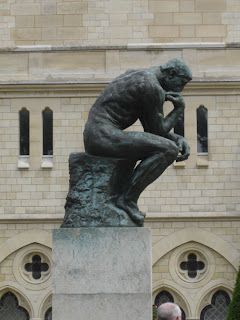Luehrman reporting from Paris:
Today we visited a little gem called the Orangerie Museum. Back in the time of the "ancien regime" a pair of buildings were built in the Louvre Palace Gardens (the Tuileries) to house exotic plants, including orange trees and other citrus, during the coldest weather, thus the name "Orangerie." The Minutemaid company didn't exist back then evidently and the King wanted his orange juice squeezed fresh. Monet's penultimate works, his pair of 360 degree panoramic waterlily ensembles, are housed in this wonderful little museum, just newly remodeled and reopened last year. We had it all to ourselves this morning thanks to Chris Willey's good work scheduling our group appointments in advance before we left. The rest of the museum is filled with works from some of the great artists working in Paris during the first three decades of the 20th century, all assembled by and donated from the private collection of Juliette Walters who was married to Paul Guillaume, a Paris art dealer of that time. Many works by Renoir, Cezanne, Rousseau, Modigliani, Matisse, Picasso and others. A delightful stop on our journey!
As you can see from the pictures Chris published on here earlier, after the Orangerie, some of us visited the Chateau de Vincennes, a real castle on the edge of the old city of Paris that was one of the royal residences for the Kings of France off and on for nearly 400 years from the time of the 100 Years War (those pesky English!!) until the French revolution. The "Donjon" castle "keep" is the tallest in Europe. When the Kings weren't living there they turned it into a prison and imprisoned annoying writers in the bleak stone cells. And, speaking of annoying writers, if I don't shut up they might slap me in irons and find me a nice little stone room. I'm out!
ML













































